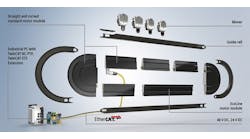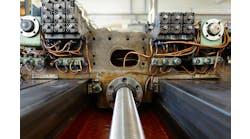As I heard my blind and deaf dog, Princess, bang her head off a wall for about the 10th time the other day, I realized that a dog isn't always just a dog. Different dogs need to be handled differently. Princess' sight failed quickly, and it was time to break out of the dog house and manage her differently.
With some careful thought, it was clear that additional requirements were needed when handling Princess. For the dog to do her business, we can't just let her roam the fenced yard, a leash and guidance would now be required. We would also need to release her at the same spot, pointing the same direction, in the house to minimize her confusion. Additional safety hardware was also needed to protect her nose, head and nonfunctioning eyes.
These simple, additional dog-handling techniques made for a much happier dog owner, me. It also reminded me of many of everyday-life and engineering FUBAR problems that occur during mechanical and control design. To paraphrase Einstein, he said everything should be made as simple as possible, but no simpler. I'd like to add that, even though it is simple, it requires that work is done.
Sometimes a guess isn't good enough, so do the job, and don't oversimplify. When fences, decorations and broadcast scaffolding were torn apart during high winds in Glendale, Arizona, during the 2017 NCAA Final Four, I cannot help but think about the ethics of engineering and building. Every engineer knows that the wind will blow over the scaffolding if not properly designed. The structural calculations and support methods, to withstand the 43-mph winds that occurred don't take a rocket scientist to understand and solve. It didn't take a dog whisperer to figure out how to keep Princess' cute face damage-free either. Whether it's a new or existing machine, scaffolding or a dog's face, it takes a bit of careful thought and minimal engineering to get it right.
Speaking of under-engineered things, if you’re making hundreds or even thousands of parts a day on a wooden table top, you sure know how to under-engineer a lean machine into a debris-creating process. I have seen wooden frames and table tops in medical clean rooms. I wonder how many engineers and operators saw it and knew it was wrong, similar to my dog's milky eyes. My guess is many saw the bad design, but more thought the scaffolding was going to blow over. Ethically, a little more cause-and-effect analysis or a few structural calculations are necessary. If someone can get injured or killed, shouldn't the engineering be well-thought-out, double-checked and maybe even oversized in some cases?
Yes, some things shouldn't be guessed at, and over-engineering is not a bad thing; but over-engineering shouldn’t happen just because you don't want to do the calculation or error analysis. Calculate safety margins; don't guess. And check the installation, or the scaffolding will fall over. Brute-force engineering as a guess leads to machine bases with 4-by-4-by-1/4-inch square tube steel machine bases, which are very rigid but heavy enough to bust through a raised floor in a clean room. What a waste.
Ethically, is it OK to just guess and pick a 10-A, 24-Vdc power supply instead of completing some simple power calculations on a spreadsheet to determine the load requirements? Do the calculations, and there will likely be cost savings, reduced heat load in the enclosure and improved efficiency. You will also probably catch when 10 A is not enough for the designed load.
If an innovative, well-thought-out OEM design has worked great for the past 20 years, is the OEM's controls designer ethically required to update the system to current safety standards? Its emergency stop, using a simple, old-school master control relay, has worked fine on hundreds of machines, even without meeting safety integrity level (SIL), category (Cat.) or performance level (PL) requirements. There is no guessing here. Both ethically and legally, safety standards must be met. Fix it.
ALSO READ: The popularity of integrated control and safety continues to improve
It's also a good idea to review the National Electric Code (NEC) to keep from burning down the plant due to improper motor protection circuits or nonexistent branch-circuit protection. Time and money are well-spent following the NEC. However, ignoring just a few codes can cause safety hazards.
Following wire-color requirements found in NFPA 79 is relevant. A blue wire is usually 24 Vdc, and, if used as a 208 Vac conductor, it could be a safety hazard to the guy who knows the standard. Even worse would be using a green wire for any live voltage. It should be the ground and non-current-carrying.
We have lots of coyotes in Arizona, so, after some careful, ethical thought, I decided not to rope my dog to a post in the middle of the yard, like a goat, even though it could eliminate the systemic problem. Now, about that coat hanger.






